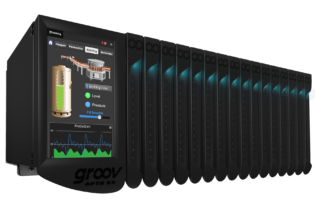I was so busy during the ARC Advisory Group Industry Forum last week, that I just couldn’t find time to write coherently. The keyword was digital supplemented by embedded, edge, IIoT, security, and transformation.
The Forum attracted perhaps not only its largest attendance but also its largest attendance of end users. The things that appeal to me are those that fit into the Industrial Internet of Things the most. Here are two related new product releases. The first one involves embedding HMI/SCADA software and the second involves using that embedded software in addition to many other technologies for an edge device.
First is the announcement from Inductive Automation concerning the creation of its Ignition Onboard program. The program involves device manufacturers embedding Ignition and Ignition Edge software in the devices they manufacture.
The program includes Ignition Onboard and Ignition Edge Onboard. Ignition by Inductive Automation is an industrial application platform with tools for building solutions in human-machine interface (HMI), supervisory control and data acquisition (SCADA), and the Industrial Internet of Things (IIoT). Ignition Edge is a line of lightweight, limited, low-cost Ignition software products which empower solutions designed for edge-of-network use.
“Device manufacturers have joined Ignition Onboard in response to their customers’ demands for an all-in-one solution that contains hardware and software at a reasonable price,” said Don Pearson, chief strategy officer for Inductive Automation. “These are companies that understand the importance of building a strong IIoT, and we’re very happy to be collaborating with them.”

The other announcement came from Opto 22. This is a significant advance in edge devices for industrial and SCADA applications.
The new groov EPIC system from Opto 22 combines I/O, control, data processing, and visualization into one secure, maintainable, edge-of-network industrial system. groov EPIC lets engineers and developers focus on delivering value, not on triaging loosely connected components.
“We are a company of engineers inspired and driven to create products that unleash our customers’ imaginations,” says Mark Engman, Opto 22 CEO. “groov EPIC is a culmination of that mission, a response to industry requests to more wholly integrate IT and OT technologies, simplify development and deployment, and provide a platform for long-term growth now and well into the future.”
Combining reimagined intelligent I/O with an embedded Linux real-time controller, gateway functions, and an integrated display, groov EPIC offers field-proven industrial hardware design with a modern software ensemble, to produce the results that visionary engineers want today.
Connecting legacy systems, controlling processes and automating machines, subscribing to web services and creating mashups, acquiring and publishing data, visualizing that data wherever it is needed, and mobilizing operators—all of these are now within reach. In addition, groov EPIC simplifies commissioning and wiring and helps engineers develop rapidly and deploy quickly.
“The groov EPIC system incorporates in one unit everything needed to connect and control field and operational devices and data, through on-premises IT databases, spreadsheets and other software, to cloud storage and services—and back again,” says Benson Hougland, Opto 22 vice president of Marketing & Product Strategy. “This ability to easily exchange data and use it where needed opens opportunities automation engineers have not had until now. This is a truly new system that builds on the past but looks fundamentally to the future of our industry.”
Of particular interest to original equipment manufacturers (OEMs) will be optional access to the Linux operating system through secure shell (SSH). This access, along with toolchains and interpreters for Java, C/C++, Python, JavaScript/Node.js, and more, allows OEM developers to execute their own custom developed applications on this ruggedized, edge processing control system.
The main point of discussion between Benson and me lately is whether Sparkplug (from the developer of MQTT) is adequate for IoT applications. He favors the lightweight (technical, not pejorative) protocol or I tend to favor OPC UA over MQTT as a better overall solution due to its interoperability. But that’s OK. He and I have had these technical discussions for almost 20 years now. I love pushback, and I think Benson does as well. It raises the energy level.






Trackbacks/Pingbacks